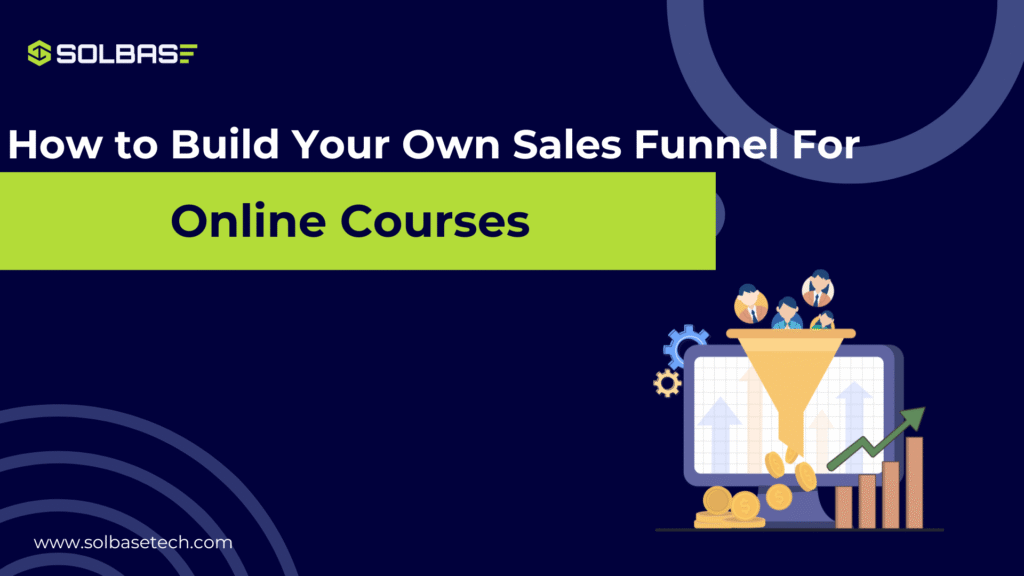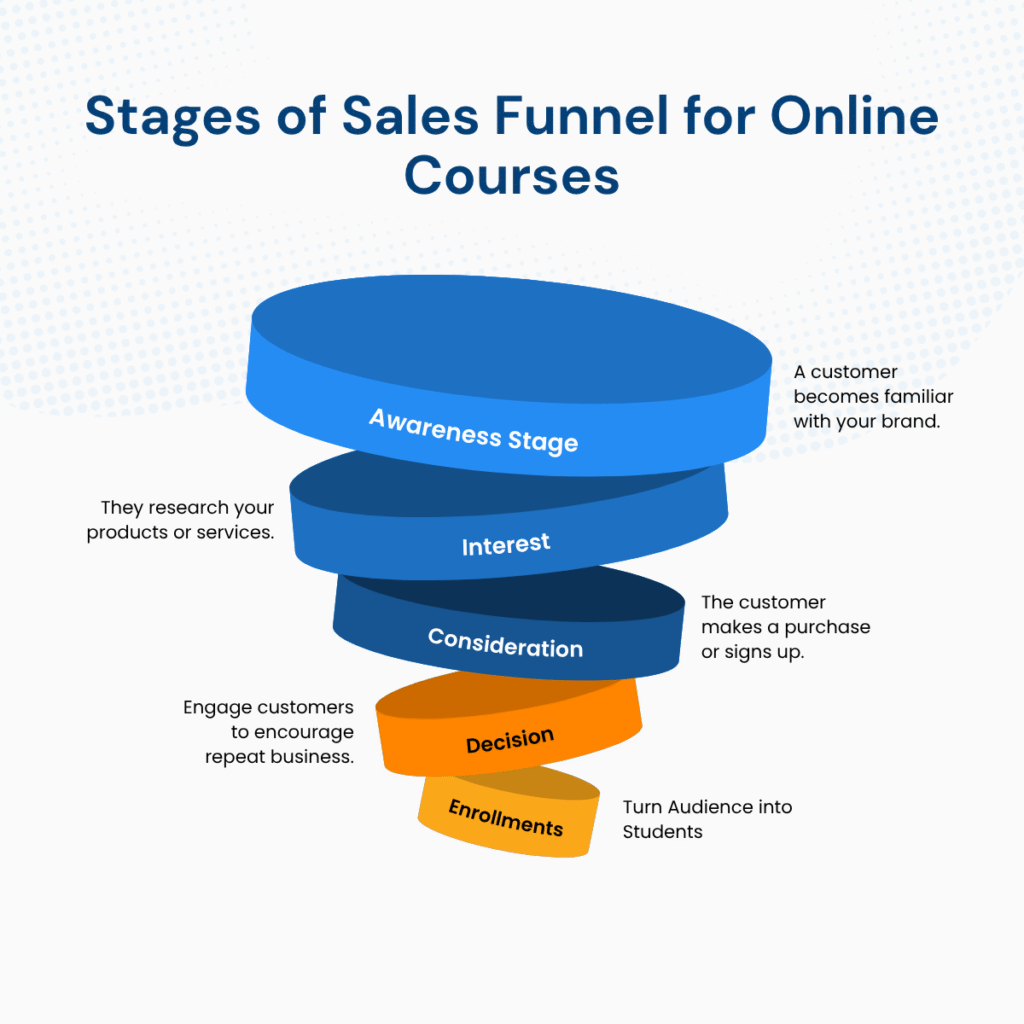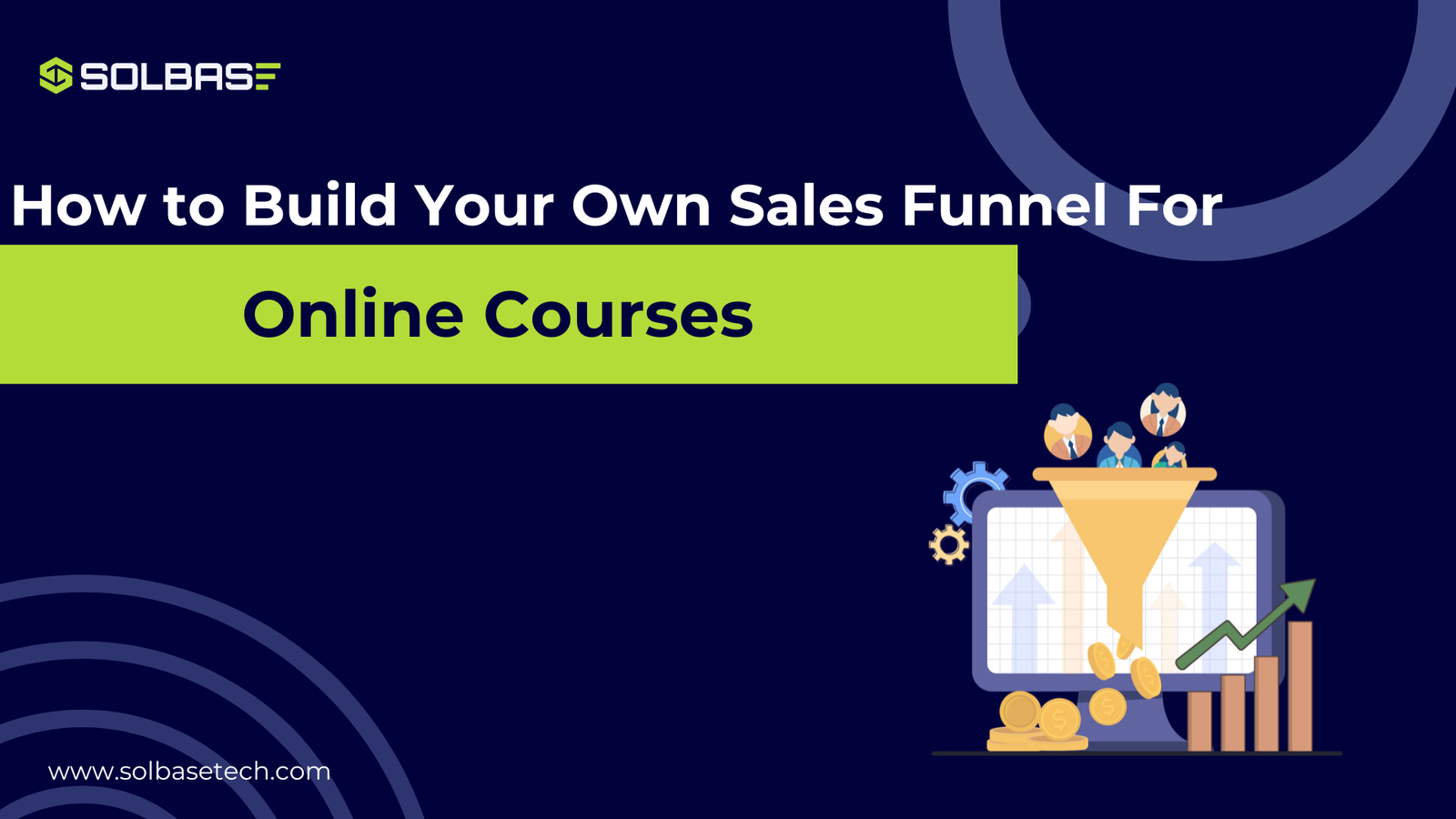How to Build Your Own Sales Funnel for Online Courses

If you’ve ever created an online course and wondered why it’s not selling? The problem isn’t always the quality of your content, not your paid ads or SEO, it’s the missing funnel structure that guides your audience from curiosity to enrollment. The solution lies in building a sales funnel for online course success that takes potential learners through every stage, from thinking to purchase.
In this blog, You’ll know the gap in your funnel strategies and how to design a course sales funnel from scratch? Why do you need it for your online courses? So get ready for creating a course sales funnel that generates sales, builds trust, and converts leads into students who are ready to learn.
Lets dive in!
What Is a Course Sales Funnel
Before making a sales funnel, we must first understand what a course sales funnel is and why it is different from other funnels.
A course funnel is the journey a potential student takes from the first time they hear about your course until they finally enroll. It’s a planned marketing system that allows you to move your audience from one stage to another with clear direction.
Each stage of a sales funnel for online course creation focuses on one goal helping learners make an informed decision. This process saves you time, automates your marketing, and makes your business predictable instead of uncertain.
In simple words, a course funnel helps you:
- Capture attention with valuable content
- Build interest with the right message
- Encourage action through trust and proof
When built properly, your online course sales funnel becomes a system that runs even while you focus on creating better lessons.
But the real question is!
Why Do You Need a Sales Funnel for Online Courses
Having a great course is not enough. Without a proper course funnel, potential students may visit your website, feel interested, and still leave without enrolling. A sales funnel closes that gap.
Here’s why you need it:
- It builds awareness among people who have never heard of your course.
- It builds trust with consistent and helpful communication.
- It improves conversion rates by presenting your offer at the right time.
- It automates the entire process, saving you hours of manual effort.
- It increases your revenue by guiding learners through upgrades or bundle offers.
When you apply this approach, you shift from random sales to consistent enrollments that grow your learning business.
The Core Stages of Your Sales Funnel for Online Course

Every sales funnel has stages that represent how a learner moves from stranger to student. These are the key stages of a course sales funnel:
- Awareness: People discover your course through content, ads, or referrals.
- Interest: They explore your course details and see how it can help them.
- Consideration: They evaluate your offer, pricing, and credibility.
- Decision: They’re ready to buy but need reassurance or bonuses.
- Enrollment: They make the purchase and become a student.
Each step needs a clear message and action. When you plan these well, you reduce confusion and increase conversions naturally.
Planning a Sales Funnel for Online Courses
Planning your funnel is where strategy meets structure. You need to understand your learners, create the right offer, and design a smooth path to purchase.
1. Identify Your Target Audience
Start by understanding who your learners are.
Ask questions like:
- What problems do they face?
- What results are they looking for?
- Where do they spend their time online?
Use audience research tools such as Google Analytics or Facebook Insights. Talk to real learners through surveys. The more you know about them, the more specific your funnel message becomes.
Also Read: How to identify right audience for your elearning course
2. Understand the Stages of Your Sales Funnel
Each stage of your sales funnel should have a goal and a next step.
- Awareness
- Interest
- Consideration
- Decision
- Enrollments
When every stage connects to the next, you’ll create a natural path that encourages people to act.
3. Create or Validate Your Course Idea and Content
Before you promote your course, make sure people want it.
- Research trending topics using tools like Ahrefs or Google Trends.
- Join communities and see what questions people ask.
- Create a free mini-course or webinar to test the idea.
If the response is strong, you can move forward confidently. Validation ensures your funnel promotes something people already want, not something you have to convince them to need.
4. Identify the Best Channels and Platforms to Promote Your Course
Promotion is how you fill your funnel with leads. Choose platforms that fit your target audience.
Some good options include:
- Social media: Facebook, Instagram, and LinkedIn groups for professionals.
- Email marketing: nurture leads with short, helpful emails that build trust.
- Paid ads: reach specific audiences faster with targeted campaigns.
- Partnerships: collaborate with influencers or other educators in your field.
We recommend using an LMS platform that integrates easily with marketing tools. You can explore our LMS and marketing automation features here: https://solbasetech.com/
Create Online Course Sales Funnels: Core Stages
Now let’s break down each stage of your sales funnel for online course creation and more importantly, how you can build each one.
Stage 1: Awareness (Getting in Front of the Right People)
The first step in a sales funnel is to make people aware of your online course. At this stage, your main goal is to let your target audience know that your course exists and can help solve their real problems.
You should create helpful and interesting content that matches what your audience needs and searches for. Share blogs, short videos, or social media posts that give useful tips related to your course topic.
The key goal here is simple: get their attention, build trust, and help them understand how your course can make their life or career better.
How to build this stage:
- Create helpful content: Write blogs, make YouTube videos, or record short lessons around your course topic. Focus on problems your audience searches for.
Example: “How to design a website in one week.” - Use SEO properly: Add your keywords naturally in titles, URLs, and headings.
For example, use phrases like “course funnel” or “how to sell an online course” in your blog post titles. - Be present on social media: Share quick tips, mini-lessons, or behind-the-scenes posts. Engage in discussions rather than just promoting.
- Run awareness ads: If you have a budget, use simple Facebook or Google Ads to drive traffic to your blog or free resource page.
Your goal: Make people aware of who you are and what you teach, not to sell yet, but to earn audience attention for online courses.
Stage 2: Lead Capture (Turning Visitors into Contacts)
Once people know you exist, invite them to connect with you directly. This is where you collect leads.
How to build this stage:
- Offer a lead magnet: Give away something useful for free, such as a short eBook, checklist, or free video lesson.
Example: “5 Mistakes New Marketers Make Before Launching a Course.” - Create a landing page: Use a simple page builder (WPFunnels, LearnDash, or Elementor). Add a headline, short description, and a signup form asking for name and email.
- Add trust signals: Show your name, photo, or small testimonials if you have them.
- Automate email collection: Connect your landing page to an email platform like ConvertKit, ActiveCampaign, or MailMint.
Your goal: Exchange something valuable for their email address so you can follow up later.
If you want to learn how to connect your funnel with your LMS platform, see the resources on SOLBASE.
Stage 3: Nurture (Building a Relationship That Converts)
People rarely buy a course right after seeing it. They need to trust you first. This stage uses automated communication to build that trust.
How to build this stage:
- Set up a 5-email welcome series.
- Email 1: Thank them for joining and deliver the freebie.
- Email 2: Tell a short story about why you started teaching this course.
- Email 3: Share a helpful tip or case study that shows your results.
- Email 4: Talk about the transformation your course offers.
- Email 5: Invite them to learn more or join a free webinar.
- Be consistent: Send 2–3 emails per week. Keep them short, friendly, and helpful.
- Include a call to action: End each email with a link to your course or your main landing page.
Your goal: Build trust and show expertise through genuine teaching before asking for a sale.
Stage 4: Conversion (Making the Sale Easy and Clear)
Now your audience is warm and ready to enroll. The goal is to make the buying process simple, clear, and exciting.
How to build this stage:
- Create a clear course sales page – Use one page to show:
- The problem your course solves
- What students will learn
- Proof of success (testimonials or screenshots)
- Bonuses or guarantees
- A single “Enroll Now” button
- Simplify checkout – Use a secure payment gateway (Stripe, PayPal, Razorpay). Keep your form short — name, email, and payment info only.
- Offer urgency and bonuses – Add a limited-time discount or free resource for early students.
- Send a confirmation email – Immediately after payment, send login instructions and a warm thank-you message.
Your goal: Make enrollment effortless so no one gets stuck or confused.
Stage 5: Retention and Upsell (Keeping Students Engaged)
Once someone joins, the next goal is to keep them learning and encourage them to buy again later.
How to build this stage:
- Onboard properly – Send a welcome email with a clear start guide. Add a short video walking them through the platform.
- Engage regularly – Use LMS features to send reminders or progress emails. Host live Q&A sessions or small challenges to motivate them.
- Ask for feedback – After completion, send a short survey. This helps improve your next funnel and course content.
- Upsell other offers – Introduce advanced courses, coaching sessions, or digital products once they complete the first course.
Your goal: Turn new students into loyal members who continue learning from you.
Stage 6: Analyze and Improve (Keeping Your Funnel Strong)
Building a course sales funnel isn’t a one-time task. You need to keep improving it with data.
How to build this stage:
- Track performance metrics:
- How many visitors sign up for your free offer?
- How many open your emails?
- What is your enrollment conversion rate?
- Test one thing at a time:
- Try new headlines on landing pages.
- Change the placement of your CTA button.
- Experiment with video vs. text on your course page.
- Use analytics tools: Google Analytics, Hotjar, and your email dashboard help you understand user behavior.
- Repeat what works: Once you find a pattern that converts well, keep it and apply it across new courses.
Your goal: Make every version of your funnel better than the last.
Must Read: How to create LMS learning path
FAQs
1. What is the main goal of a sales funnel for online courses?
To guide learners step-by-step from discovery to enrollment through structured communication and content.
2. How long does it take to build a course funnel?
Usually 2–4 weeks if you already have your course ready and know your target audience.
3. Can I do this without ads?
Yes. Start with organic content, SEO, and email marketing before moving to paid ads.
4. What tools are best for course funnels?
Use LearnDash or Kajabi for course hosting and tools like WPFunnels or MailMint for automation.
Conclusion
A well-designed sales funnel for online course success doesn’t just bring more sign-ups, it builds a real connection with your learners. Each stage, from awareness to retention, plays a part in turning interest into action.
Start simple: write one blog, create one lead magnet, send a short email sequence, and track what happens. With time, your online course sales funnel will grow into a powerful system that works for you 24/7.
Want Expert Help?
👉 Explore Our LMS Services at SOLBASE Technologies we specialize in LMS setup, funnel automation, and course marketing strategies.
Our team helps course creators like you build sales funnels that sell automatically while you focus on teaching.



